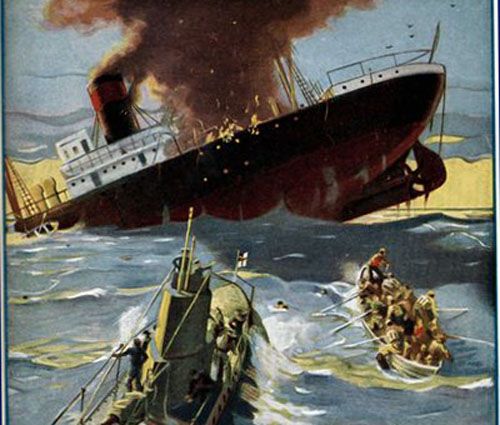
At the start of World War One Britain was quick to use her warships to assert her supremacy in the sea.
By September, 1914 the British Fleet in the North Sea had settled down to the task of holding the coasts of Germany and the channels leading to them in a state of blockade.
On this day 100 years ago, not far from the Hook of Holland the cruisers Cressy, Aboukir, and Hogue, each carrying 755 men and officers, were engaged in this work when without warning the Aboukir was overwhelmed by a flash of fire, a pillar of smoke and a great geyser of water that rose from the sea and fell heavily upon her deck. Instantly followed a thundering explosion as the magazines of the doomed ship went off. Within a very few minutes, too little time to use their guns or to lower their boats, the Aboukir sank leaving the crew floundering in the water.
In the distance lay the German submarine U-9 one of the earliest of her class in service. From her conning tower Captain Weddigen had viewed the tragedy and seeing the two sister ships speeding to the rescue he quickly submerged. Hardly had they begun lowering their boats when a torpedo from the now unseen foe struck the Hogue and in twenty minutes she too had vanished. While she was sinking the Cressy, with all guns ready for action and her gunners scanning the sea in every direction for this deadly enemy, suddenly felt the shock of a torpedo and, her magazines having been set off, followed her sister ships to the ocean’s bed. In under two hours thirty-six thousand tons of up-to-date British fighting machinery, 1397 blue jackets and 62 officers had been sent to the depths of the North Sea by a little boat of 450 tons carrying a crew of twenty-six men.
This event heralded the arrival of a new and deadly force into the arena of warfare at sea. Shock at the swift death of so many caused by so few was mingled a feeling of amazement at the scientific perfection of the submarine, its power, and its deadly work. Many at the time said it was the end of dreadnoughts, battleships, and cruisers, but in fact it was transport and merchant ships which were the main target of submarines. The world at large seemed to think that the submarine was an entirely new idea and invention but like almost everything else it was merely the ultimate reduction to practical use of an idea that had been germinating for many years. By the beginning of World War One this idea had been developed for practical use as a weapon of war by the almost all the main participants, including Australia who had two submarines, used them to some effect during the war. But it was the lethal application by Germany whose sea fleets had been blockaded that saw the most deadly use of submarine fleets.
Once World War One started in 1914 it was the complicated treaties arrangements which drew country after country around the world into the conflict. But the United States of America while traditionally aligned with many of the allied countries had no treaties which obligated it to join on one side or the other. As a result America sat on the sidelines along with a number of other countries.
But arguably the thing that fueled the flames for war and eventually dragged the United States into the conflict was not the belief in the ideals and rights of the allied powers but an amendment to international law. In ?? Germany made changes contrary to international laws by instructing their submarine commanders of the duty of visiting and searching a vessel, or of giving its people time to provide for their safety, before sinking it.
The German argument revolved around the fact that the submarine was a new weapon of war and unknown when the international law was formulated. There was some truth in this for the submarine was a peculiarly delicate naval weapon whose strength lay in its ability to keep itself concealed while delivering its attack. If exposed on the surface a shot from a small calibre gun striking in a vital point would instantly send it to the bottom. If rammed it was lost. Should a submarine rise to the surface, send an officer aboard a ship it had halted, and await the result of his search, it would be exposed all the time to destruction at the hands of enemy vessels coming up to her aid. Indeed if the merchantman happened to carry one gun a single shot might put the assailant out of business. Accordingly the practice grew up among the Germans of launching their torpedoes without a word of warning for their helpless victim.
However the German’s extended their licence beyond warships and even merchant vessels and in May 1915 had sunk without warning the passenger liner, Lusitania, which saw more than eleven hundred people drowned, one hundred and fourteen of them American citizens. Finally in late in January, 1917, Germany announced it would no longer comply with international law and began a campaign of unlimited submarine action sinking ships without warning and irrespective of their nationality once they appeared in prohibited zones set up by Germany. Within twenty-four hours the United States had sent the German Ambassador home and within two months they were at war.
Von Tirpitz and other leaders in the German administration had promised their people that within six weeks England would be starved and begging for peace at any price. The Germans estimated that if they could sink 1,000,000 tons of shipping monthly they would put England out of action and for some weeks approached this estimate, but gradually activity fell off.
References
Willis J. Abbott, Aircraft and Submarines, The Story of the Invention, Development, and Present-Day Uses of War’s Newest Weapons, 1918



